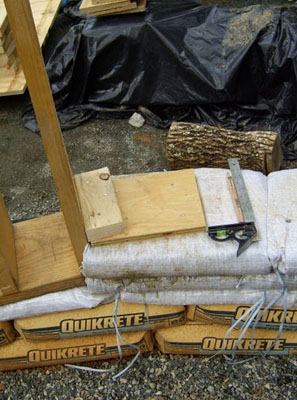EarthbagBuilding.com
Sharing information and promoting earthbag building
| Home | History | Resources | Slide Show |
| About Us | Projects | Plans | Videos |
| Blog | FAQ's | Workshops | Testing |
| Search | Articles | Bulletin Board | Shelter |
| How to Make Doors in Earthbag Buildings Questions answered by Kelly Hart |
Q: I'm creating some construction notes for a dome and I want to confirm the size and shape of the entry columns. Your dome guide shows how to do this in detail. Are the entry columns the same for 3' and 6' wide openings? A: The buttressing columns were the same for both door sizes. I used the double, cross-hatch pattern of sewn or stapled bags for both. These do take up a lot of space, and while I think they are necessary for the 6' arches, they are probably over-kill for the smaller sizes. The arches themselves over the 6' span were also a continuation of the double cross-hatch pattern, which is astoundingly strong...so I would recommend it for large spans. Q: Are the arched doorways and windows often seen on domes worth the effort? They are attractive, obviously, but I imagine they take more time to construct (vs a wooden beam for a lintel, for instance). Also, don't they require a bit more carpentry skills for finishing, what with the curved space above the door or window to deal with? A: (Owen Geiger) There are various ways of building arches. Yes, the typical method of using fan bags is slow, although I think it's really fun. Khalili's method of using long tubes of stabilized soil seems really fast. You could buy tubes just for going over arches. Wood lintels are less practical, because the dome is round and must support the massive load above it. And what if termites slowly eat the wood over the years... Q: So here's the scene: 14 x 14 earthbag dome, 2-3 feet underground; one arched doorway directly south 36 x 78 inches; arched window`frames directly SE and SW, both 36 x 54 inches; another arched door identical to the first directly west, and two more arched windows, also 36x54 inches, located directly North and East. Should we have to buttress these arched windows and doors, could we buttress inside with built in furniture/shelving. Also, do you see a problem with a skylight at the apex of the dome, should this effect the structural integrity or weaken any cantilevered compression tension happening at the apex. A: A 14' dome with two doors and four windows will create a lot of openings that will weaken the basic structure of the dome. The 14' dome I made (pictured here) has only one door and two windows at ground level. If you look at the plan for this little dome, you will notice that the door is naturally buttressed by insetting the door frame within the dome and making it vertical to meet the curvature of the dome near the top. The windows were not buttressed, but then they were formed with simple circular culvert couplers inset in the walls, and thus became part of the structure itself. On another dome I did make a kind of interior buttress around an arched, openable window by placing an interior bench below it that helped support long sewn bags up over the arch, placed perpendicular to the wall. There are many other strategies for buttressing door openings pictured on the project pages. You can place a skylight at the apex of the dome if you support it with a strong, rigid framework (or compression ring) that will lock into the bag structure. Q: I cannot visualize on a dome what happens to the door frame when you move inwards in the dome formation...so of course if you have a 5" wide door post, your doorway is soon has no frame support. Can you advise....or am I having problems like this because I only have a 2m diameter on my dome to start with? A: Doors on small domes need to be created with extensions of the wall either inward or outward, as you have discovered. This is good because it also gives that entrance an automatic buttress effect. Q: I have been trying to come up with an earthbag dome design with large (arched) openings for solar gain, and have just found out that you already achieved this on your bedroom and living room domes in Colorado. I'm really very impressed by the size and beauty of the openings and would love to incorporate them into my own design. What I don't understand though, is how you achieved such large openings without buttressing - at least I can't see any outside buttresses in the pictures. Avoiding exterior buttressing seems key to me, as I'm afraid it would block out a lot of sunlight, thereby defeating the purpose of large openings for solar gain. Can you explain some more how you managed to create these large arched A: Those large, six-foot earthbag arched openings actually were buttressed on the inside. If you look carefully at the photos at the project page, you will see how at the base of the opening the wall turns inward for about 4 ft. and then go vertically upward until it meets the curvature of the dome. This is shown in photos of both the exterior when the bags were still exposed, and also in one of the finished interior shots. Q: I am building of a wine house in my vineyard. I overlooked an important step - adding anchor strips for the heavy industry door. I must remove the bags just at the door frame and install them new again with the strips. Fortunately, I am only 9 bags high. Should I use a hardwood for them - and for the door frame stud? A: Here is Owen Geiger's suggestion for making door frame anchors, and I agree with what he says: As for the best wood for anchors for the frames, I think probably a harder wood would work better than a soft wood so that the screws are more secure. But for the frames themselves, either could work. Q: I am building a weinehouse in my vineyard here in Austria. I am making the anchor plates for the door and windows. Does the door and windows attach directly to the end blocks of the anchor plates or is another wood attached to them first? A: Here is a picture of one way to attach the door frame to an anchor at that looks like a good approach to me. Either doing this, or using metal brackets to accomplish the same thing would work. Q: One of the standard practices with attaching door and window bucks is to use galvanized roofing nails with bent sheets of steel, and nail one side into the bags and the other into the bucks. Thinking more about the nature of scoria, it seems like nailing into a scoria bag wouldn't really work in the same way as nailing into an earth-filled bag; the amount of airspace, and relative lack of compaction, would I'd guess not really give a nail much to drive into. What was / is your experience with attaching wooden frames / bucks to scoria walls? Is there some other method we should use? A: I did not use that method of attaching doors and windows when I built my scoria dome house. Instead I either embedded small wood blocks between a couple of bags near the opening and put threaded rods through a hole in it with a nut and washer to keep the rod from coming out. Then I used these rods as anchors for the bucks. Or on other occasions I drove the threaded rod all the way through a buttress for the door and anchored the buck in a similar manner. Q: I was wondering how easy it is to make modifications to the earthbag houses after they have been built. My reasoning is if the house is built before a family has children and then needs to add on to accommodate the new members of the family. I don't want a big home unless it's to accommodate family. A: Retrofitting doorways into existing earthbag walls can be problematic. The best solution is to anticipate possible door locations in advance and actually make the doorway during initial construction and fill it in with dummy bags. Then in the eventuality of making the addition, it is easy to punch out the bags in that place and the doorway is ready to go. Q: Some people appear to use forms wider than the earthbags (such as plywood) to ensure that the bags do not wrap around the forms. They then appear to remove these plywood forms and place door bucks in the space provided. Others appear to use a single reinforced 2x6 frame as form that can then also be left in place as door bucks. This makes more sense to me as it saves an extra step and expense. Any reason not to do the latter in the case of a lightweight scoria fill? A: I have always created door bucks that remain in place. The bags do tend to wrap around a bit, but this just keeps the frame more firmly in place. Q: We would like a lot of lot and large wood/glass doors to open to the outside and the pool, to basically have an open living space able to be closed up. Can we create these large window or door spaces with building with earthbags? A: The largest door opening that I have created with earthbags is about 6 feet wide. If you want to go beyond that you are probably better off framing that part of the structure with wood. Q: Would it be possible to go ahead and place your vinyl windows and doors using ones that come with vinyl bucks, and avoid building the forms? A: I have never worked with vinyl window frames. They would need to be robust enough to allow them to be placed in the walls where you want them and pile the bags up against them while fastening them to the bags somehow. This might work, or it might be best to also have rough wooden bucks just to be more secure. Q: Whaat is the best way to frame an access door thru a gravel bag wall to access the crawlspace? A: I would frame this with hefty wooden lumber. |
See Your Ad |
Disclaimer of Liability and Warranty
We specifically disclaim any warranty, either expressed or implied, concerning the information on these pages. No one associated with this site will have liability for loss, damage, or injury, resulting from the use of any information found on this or any other page at this site.
For Email contact go to About Us
We are interested in communication from others who are exploring the possibilities inherent with earthbag building.
Visit Our Other Websites:
www.greenhomebuilding.com
www.dreamgreenhomes.com
www.naturalbuildingblog.com

